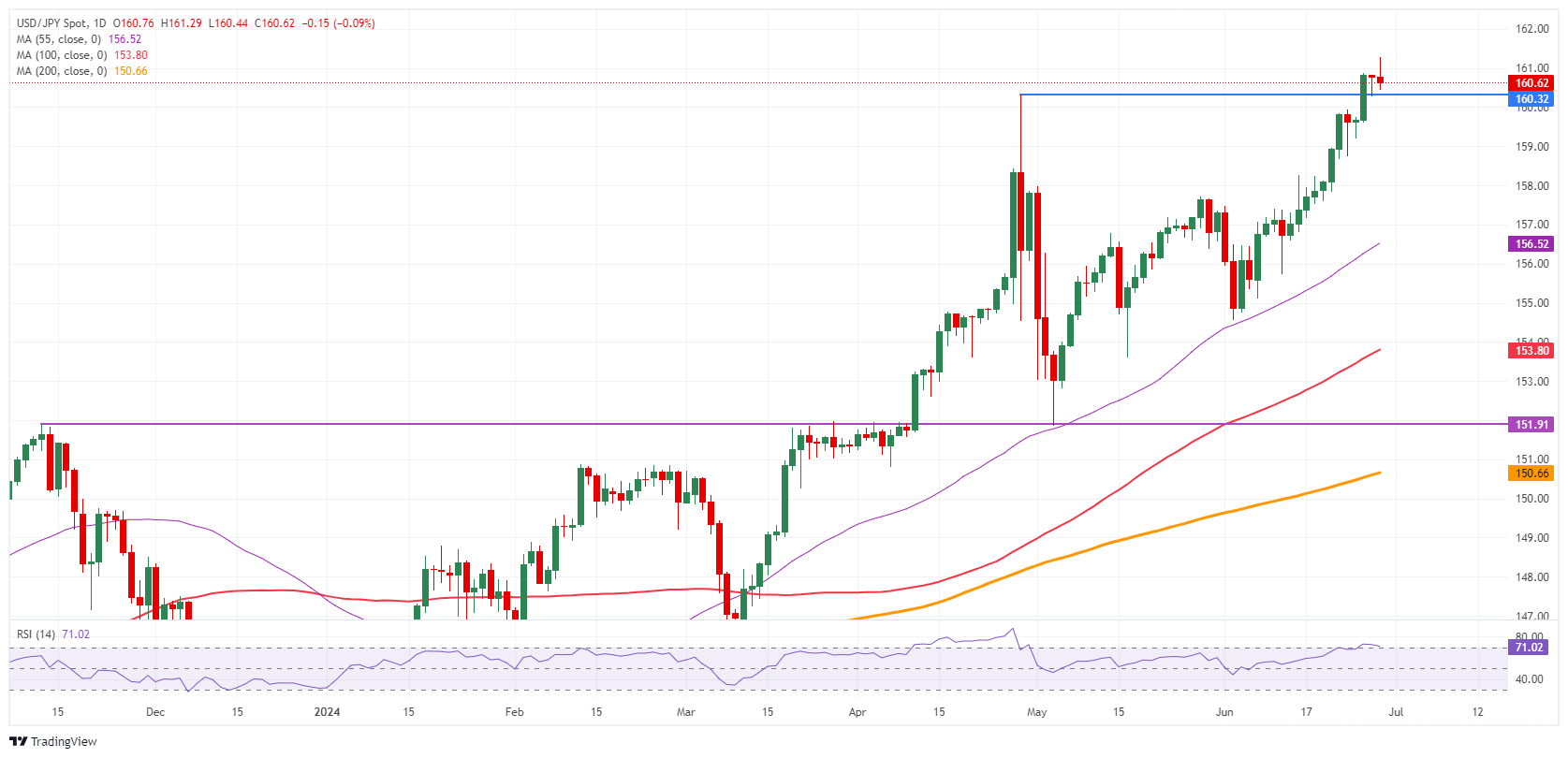Japanese Yen stronger after first printing fresh multi-decade high

- The Japanese Yen started Friday with a fresh multi-decade low print.
- Some quick profit taking is happening ahead of the US session and before the weekend.
- The US Dollar Index hovers around 106.00 again ahead of PCE inflation release.
The Japanese Yen (JPY) sees traders taunting the Japanese government yet again, with another new historic low printed in the Yen’s performance. This Friday 161.27 was briefly hit before falling back to below 161.00. The move comes with Japanese Finance Minister Shun’ichi Suzuki repeated the same message from Thursday that the Japanese cabinet is “watching the FX moves with a high sense of urgency”, which now has lost its impact and sees markets defying the Ministry in order to take action.
Meanwhile, the US Dollar Index (DXY) – which gauges the value of the US Dollar against a basket of six foreign currencies – is of course in positive territory on the back of this action. Even if US data on Thursday did not allow the US Dollar to outperform, with Durable Goods flatlining and Pending Home Sales shrinking again for a second month in a row. All eyes this Friday on the US Federal Reserve’s preferred inflation gauge: the Personal Consumption Expenditures numbers.
Daily digest market movers: Before or after the weekend
- At 02:30 GMT, Japanese Finance Minister Shun’ichi Suzuki commented he is watching FX moves with a high sense of urgency. Though this time the impact resulted in a pickup in devaluation for the Japanese Yen. Markets expected to see action this Friday, not more words and same messages.
- At 12:30 GMT, the Personal Consumption Expenditures (PCE) for May will be released. Most important will be the monthly figures:
- Headline PCE expected to head from 0.3% to 0.0%.
- Core PCE should have a soft landing from 0.2% to 0.1%.
- At 13:45 GMT, Chicago Purchase Managers Index will be released. The number is expected to remain in contraction from 35.4 to 40.
- At 14:00 GMT the University of Michigan will release June’s final reading:
- Sentiment Index expected to head from 65.6 to 65.8.
- Inflation expectations should remain stable at 3.1%.
- Equities have chosen to go out with a bang, and are printing green numbers across the globe.
- The CME Fedwatch Tool is broadly backing a rate cut in September despite recent comments from Federal Reserve (Fed) officials. The odds now stand at 57.9% for a 25-basis-point cut. A rate pause stands at a 35.9% chance, while a 50-basis-point rate cut has a slim 6.2% possibility.
- The Overnight indexed Swap curve for Japan shows a 57.9% chance of a rate hike on July 31, and a smaller 19.8% chance for a hike on September 20.
- The US 10-year benchmark rate trades around the middle of this week’s range near 4.30%.
- The benchmark 10-year Japan Treasury Note (JGB) trades around 1.05%, and is easing a touch for this week.
USD/JPY Technical Analysis: Bigger than before?
The USD/JPY has just printed a fresh multi-decade high this Friday. The catalyst for the move was the same as the one that triggered a bit of a recovery on Thursday: the words from Japanese Finance Minister Shun’ichi Suzuki. It becomes clear that markets have bought one time into these comments, and now want to see action, which is pushing the Japanese government into a corner and interventions are really looking inevitable.
Although the Relative Strength Index (RSI) is overbought in the daily chart, a correction could still take a few more days. Should PCE data come out further disinflationary, that would not be enough to drive USD/JPY down to 151.91. Instead, look at the 55-day Simple Moving Average (SMA) at 156.53 and the 100-day SMA at 153.81 for traders to quickly build a pivot on and try to test highs again, testing the Japanese deep pockets again.
USD/JPY Daily Chart
Economic Indicator
BoJ Interest Rate Decision
The Bank of Japan (BoJ) announces its interest rate decision after each of the Bank’s eight scheduled annual meetings. Generally, if the BoJ is hawkish about the inflationary outlook of the economy and raises interest rates it is bullish for the Japanese Yen (JPY). Likewise, if the BoJ has a dovish view on the Japanese economy and keeps interest rates unchanged, or cuts them, it is usually bearish for JPY.
Last release: Fri Jun 14, 2024 03:23
Frequency: Irregular
Actual: 0%
Consensus: –
Previous: 0%
Source: Bank of Japan
